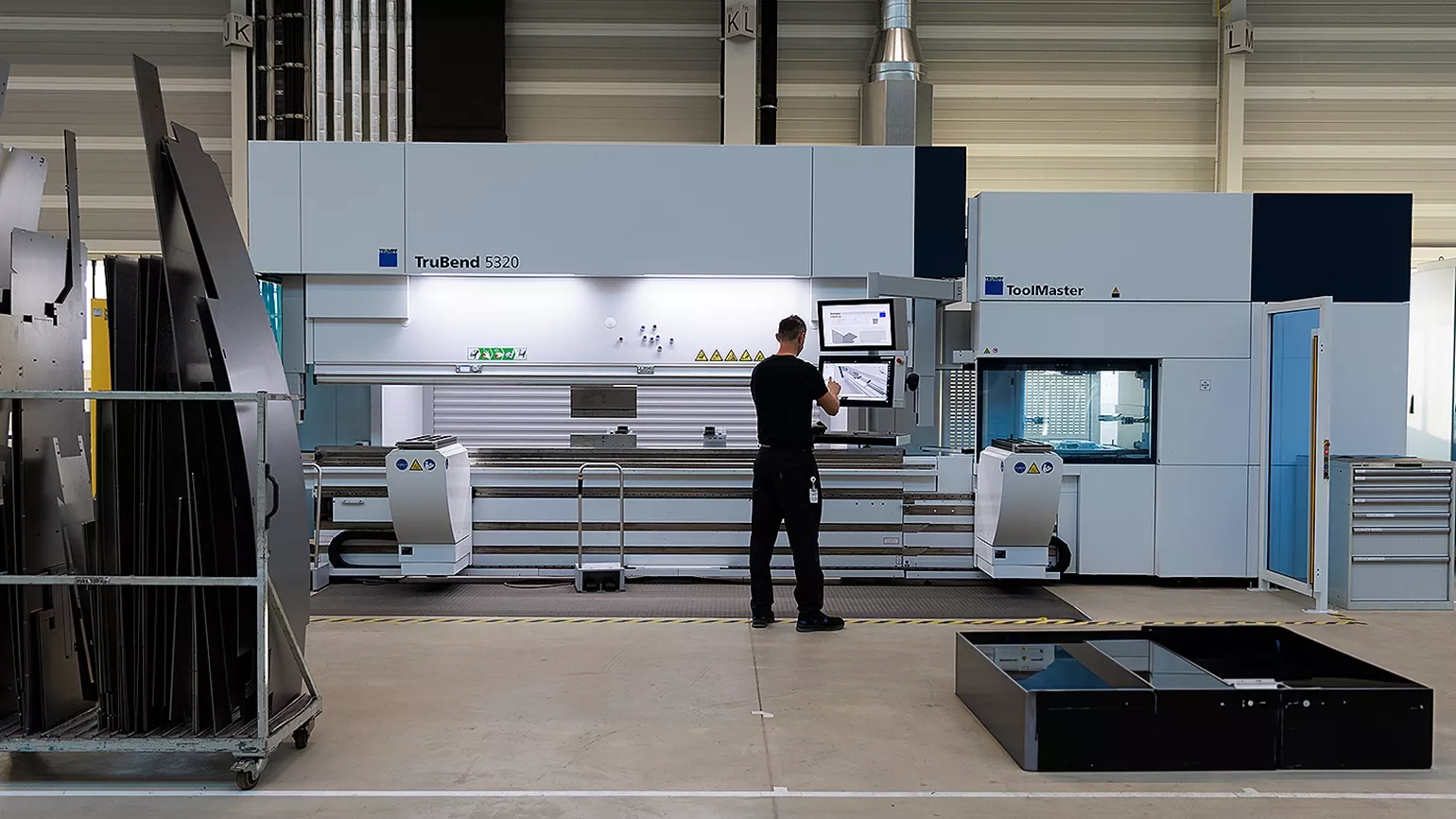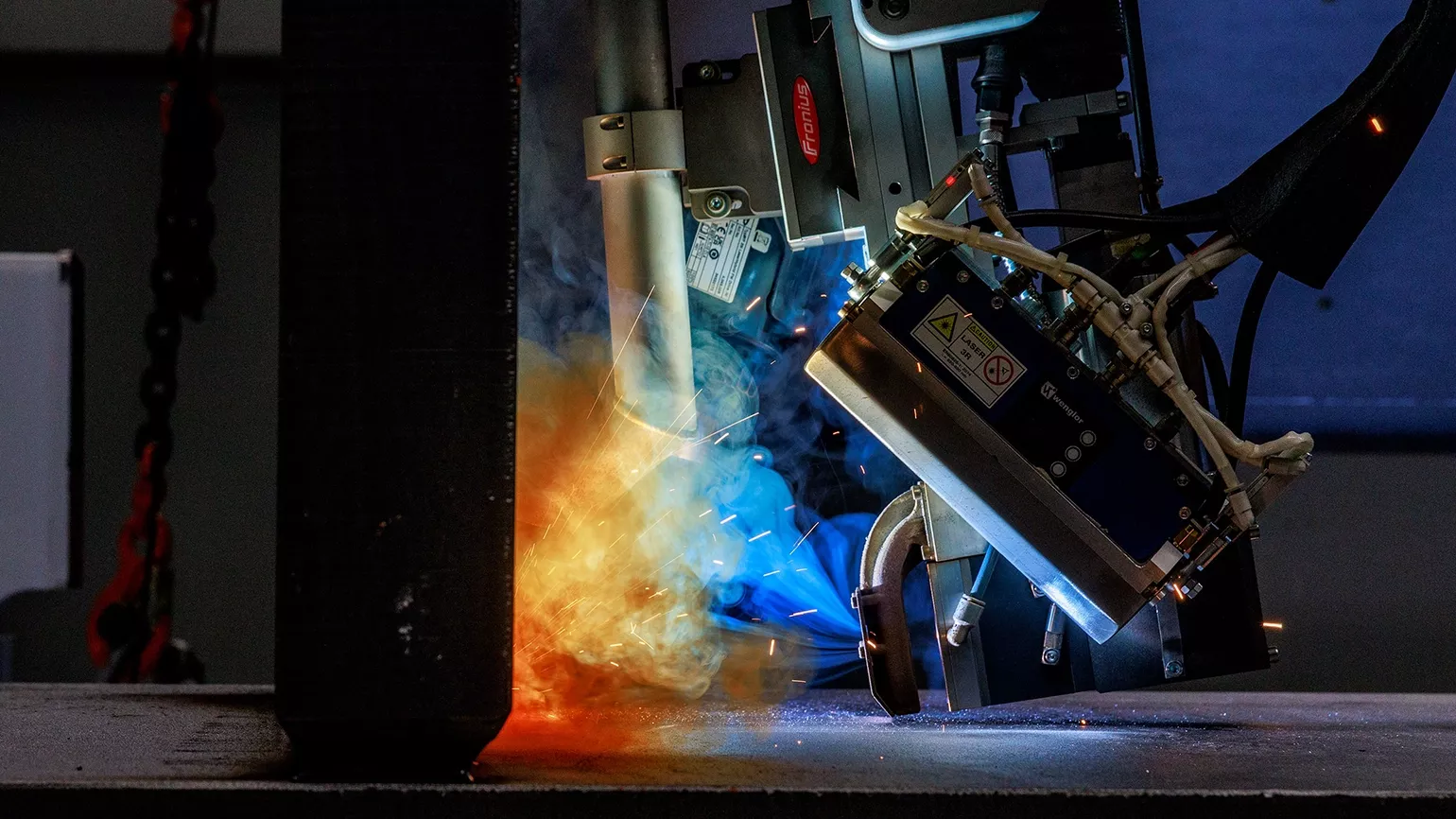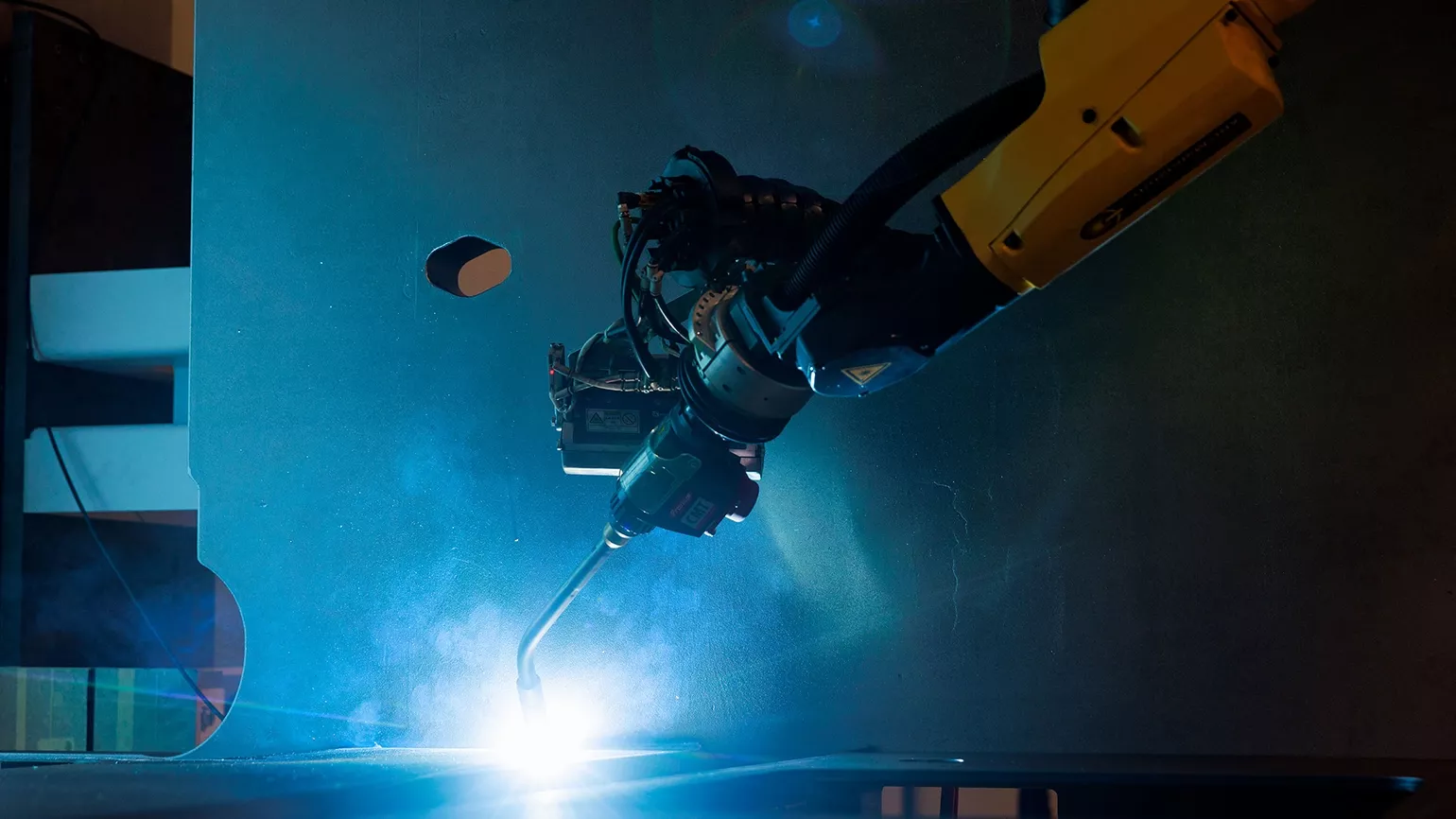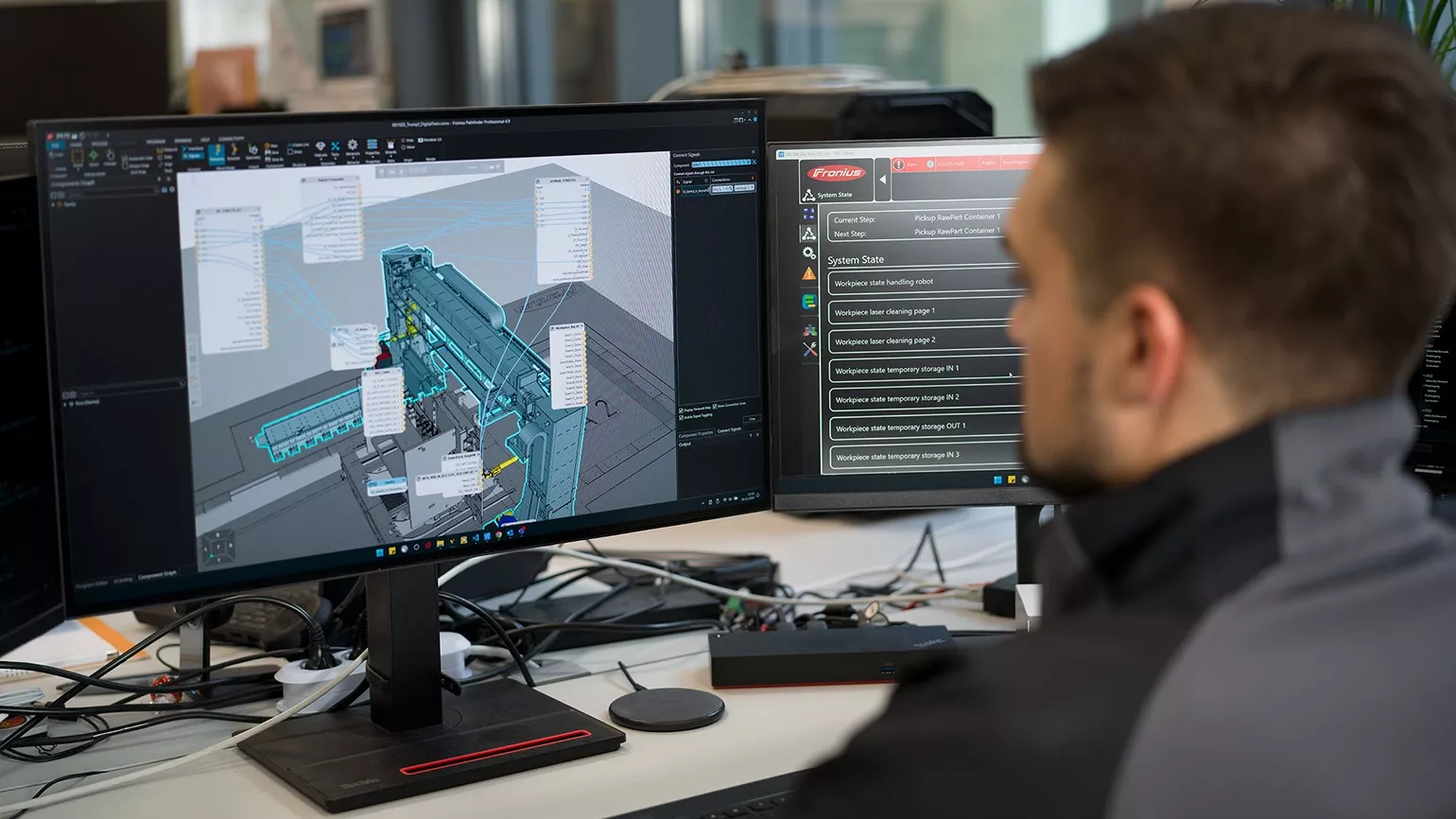TRUMPF drives efficiency
with new LaserHybrid welding system

No more outsourcing thanks to cost-effective production in-house with LaserHybrid welding system
“During spheroidizing, the steel is heated to up to 800 °C in an annealing furnace. As it heats, the material reacts with the oxygen in the air, oxidizes on the surface, and forms rust. This means the components have to be sandblasted before painting,” explains Thomas Reiter, production manager at Trumpf. “Thanks to our new LaserHybrid gantry welding system we can skip the annealing process, which takes up a lot of time and money. We use the laser to heat the steel along the weld to between 150 °C and 180 °C, depending on the material. This reduces the cooling rate after welding so we can avoid hardening, cold cracks, and corrosion. Plus, producing in-house makes us more flexible and independent.”
Optimum edge fusion and reduced tendency to form pores
The LaserHybrid welding process combines a laser beam
aimed at the weld with a GMAW welding process in the same process zone. The
highly focused laser beam boasts an extremely high energy density and
penetrates up to 10 mm deep into the steel when welding the machine
frames. Immediately after the laser comes the MIG/MAG process, which fills the
root pass and ensures optimum edge fusion. The heat that is also introduced
gives the material time to outgas, thus preventing any proneness to porosity in
comparison with pure laser welding. Depending on the sheet thickness, Trumpf
uses MIG/MAG to weld up to 29 top passes.Enhanced efficiency and material savings
LaserHybrid offers Trumpf decisive advantages over MIG/MAG-only welding. Reiter explains: “For one, we save up to four tons of welding wire and valuable working time every year, as we can skip the time-consuming process of chamfering the sheet edges, especially on thinner sheets. This keeps the weld cross-sections small and cuts down on filler metal. Secondly, we increase our productivity thanks to high welding speeds, which come as a result of the stabilized arc that LaserHybrid creates in conjunction with MIG/MAG. And thirdly, the low energy per unit length reduces component distortion.”
But there’s still a fourth aspect that also has a positive effect on consumption of filler material. The weld can be created further inwards with the LaserHybrid process, making it possible to move closer to the side parts during fillet welding and keep the air gap narrower.

Fronius comes out top in evaluation
The company therefore decided to install a two-station gantry system with one LaserHybrid and one MIG/MAG welding robot as well as two large tilt positioners that allow components to be fed in horizontally. While one machine frame is being welded in the welding cell, it’s possible to position the next one on the empty positioner for a seamless workflow.
All things considered, our proposed version turned out to be the best. A number of factors were crucial here, including a sensible safety concept, the fact that using two welding robots would eliminate the need for a torch changing station, the system’s hassle-free hosepack routing, the use of WireSense for seam tracking, and ready accessibility to corner areas thanks to the slim MIG/MAG robot. Efficient production was also guaranteed, with the two tilt positioners allowing for setup parallel to production. Other plus points that put us ahead included the partners’ long-standing and trusting business relationship, offline programming of welding jobs with Pathfinder, and the expertise our specialists had to offer around system technology.
No tool changes required
“The hollow arm of the MIG/MAG robot guarantees optimal routing of the hosepack. Hosepacks that are routed to the side often dangle unintentionally, which can cause damage or, in the worst case, even mean they come detached. There is also a risk that these hosepacks could get caught on components or devices, which can prevent robots from moving freely,” Reiter explains.

Sophisticated: two welding robots on a single rail
The welding sequences provided by Trumpf for the acceptance parts were simulated on the digital twin during the design phase using our Pathfinder offline programming software and checked for feasibility. This way, the client’s welding specialists could be made aware of potential production issues ahead of time, such as areas that are tricky to access. Wolfgang Mitterhauser, our software engineer and Pathfinder expert, played a special role here:
“I added capabilities to the postprocessor (parser) so that it can translate special commands for the MIG/MAG welding robot, such as the use of WireSense seam tracking sensors. The parser transfers the welding programs that are created from the digital twin to the actual system. The add-ons include program sections that are tailored precisely to the customer’s system and are not included in the standard version of Pathfinder,” explains Mitterhauser.
Thanks to these add-ons, system operators can specify exactly what and how much information is transferred by the postprocessor. “The result is a welding program that meets the robot’s requirements perfectly,” adds Mitterhauser.
A collision sensor can be created in the Pathfinder so any impact between the welding torch and component is detected promptly. If the virtual monitoring system detects a potential collision, the software indicates this immediately.
Welding wire doubles as a sensor
Even if all system components interconnect almost
seamlessly, there is a risk of deviations when welding layers if seam tracking
sensors aren’t used. This can lead to fusion defects such as burn-through and
inadequate a dimensions. Our WireSense function uses the wire electrode as a
sensor for weld seam detection and eliminates the need for optical measuring
aids that could impair the welding torch’s ability to access the component.
Highly precise sensing involving frequent reversing wire movements enables the
different component geometries to be recognized and the relative position of
the individual sheets to be determined extremely accurately. WireSense does not
require any add-on torch components or calibration and maintenance work. Thanks
to the innovative sensor technology, Trumpf benefits from flawless welds and
lower production costs.
Intelligent control for all processes
The user-friendly HMI-T21 RS system controls are the
core feature of the welding system, monitoring and coordinating all peripheral
components such as the robot, welding machine, tilt positioner, and torch
cleaning system. Thanks to the 3D real-time views provided by the system,
Trumpf’s welding specialists can follow all robot movements live on the
monitor. They have the option of choosing between preset views or creating
their own and saving them to ensure a perfect display at all times.
A key element of the innovative HMI-T21 RS is its program editor, which system operators can use to define the individual program sequences, assign them to a processing station, and save them as a sequence string.
Fault, warning, and information messages are displayed in plain text in the status bar. If there are no messages, all system statuses and the program sequence are displayed, with the currently logged-in user shown in the right-hand column.
Mitterhauser says: “The status overview shows the status of all available sensors. If there is a fault message, all signals can be checked using the HMI.”
Virtual commissioning and assembly
Due to the vast dimensions of the gantry and
positioner, it was not possible for us to perform the usual welding system
installation and pre-commissioning work at our site; instead, we opted for
virtual commissioning with the help of Pathfinder. Supported by the software,
we created a digital twin of the system—including all the signals defined in
the circuit diagram and realistic kinematics. Using this virtual model, we were
able to carry out simulation-based commissioning under near-real conditions.
Pathfinder also proved to be extremely useful during pre-inspection by our customer. Using virtual reality glasses, the Trumpf experts were able to experience all of the movement sequences of the two welding robots and tilt positioners—which can hold up to ten different components—under realistic conditions.
Trumpf was involved throughout the entire design phase and made a significant contribution to the success of the project by providing suggestions and feedback.
Installing the LaserHybrid welding system on site proved to be tricky; the huge dimensions of the gantry and tilt positioners, which can be swiveled up to 90°, presented a special challenge in logistical terms. All components had to be in the right place at the right time to avoid unnecessary delays. One especially challenging aspect was the night-time delivery of the two tilt positioners, which had to be transported on closed highways part of the way due to their size.
Enhanced efficiency via feasibility studies with Pathfinder
At Trumpf, the software is not only used to program and simulate new welding jobs, but also to carry out virtual checks to determine the weldability of new components. This includes asking questions such as: To what extent is the component geometry suitable for automated welding? Can the component be adequately accessed? Is there a risk of collisions? Do parts have to be welded manually, or is it in fact necessary to change the design? Detailed feasibility tests and process simulations are now saving Trumpf up to three weeks of programming time.
Conclusion: The right decision
The new LaserHybrid welding system significantly improves the
weld quality of the machine frames, increases the welding speed, and saves
valuable working time thanks to the option of offline programming and
simulation.
Thomas Reiter is very pleased with the results: “We’re now producing almost 1,500 bending
machines every year. Thanks to our new robot welding system, not only has our
work become more profitable but our delivery times are now more flexible too,
because we’re no longer dependent on buying in machine frame components. And we
also have more options in terms of production capacity now.”

